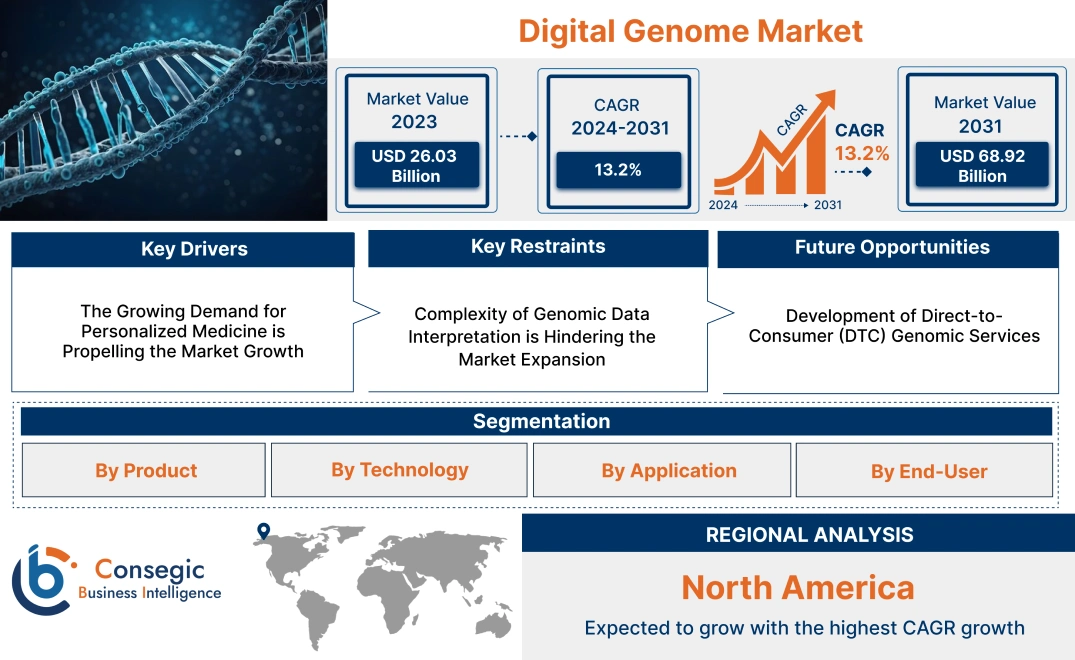- Summary
- Table Of Content
- Methodology
Digital Genome Market Size:
Digital Genome Market size is estimated to reach over USD 68.92 Billion by 2031 from a value of USD 26.03 Billion in 2023, growing at a CAGR of 13.2% from 2024 to 2031.
Digital Genome Market Scope & Overview:
A digital genome refers to the comprehensive, digital representation of a person's genetic information, encoded and stored in a digital format. It is essentially a computational model of an individual's entire genome which is used for analysis, research, and medical purposes. The market is driven by advancements in genomics, bioinformatics, and data analytics which have opened new possibilities in healthcare and research. The end users of this market encompass a diverse range who utilize genomic data and technologies for various purposes such as healthcare providers, research institutions, and genetic testing companies.
Digital Genome Market Dynamics - (DRO) :
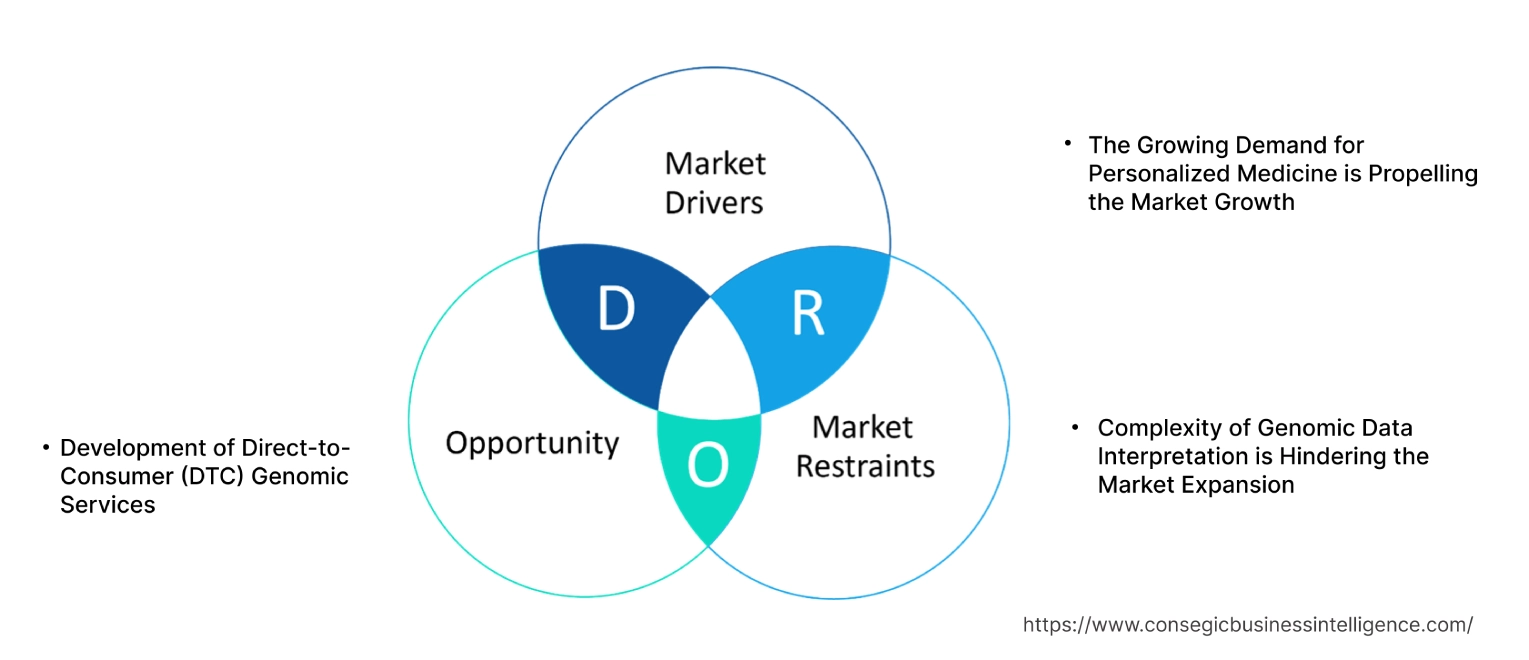
Key Drivers:
The Growing Demand for Personalized Medicine is Propelling the Market Growth
Personalized medicine tailors medical treatments to individual patients based on their unique genetic profiles, environmental factors, and lifestyle choices. The field of pharmacogenomics uses genetic data to understand how individuals metabolize and respond to drugs, helping physicians select the right medication and dosage for each patient. By selecting the most appropriate treatments based on genetic data, personalized medicine reduces the financial burden on healthcare systems caused by ineffective treatments and unnecessary procedures. The integration of digital genomes into wellness programs allows individuals to personalize diet, exercise, and lifestyle decisions based on their genetic predispositions.
- In March 2022, the pharmacogenomics field combined pharmacology and genomics to develop effective, safe medications that can be prescribed based on a person's genetic makeup. They are used to develop tailored drugs to treat a wide range of health problems, including cardiovascular disease, Alzheimer's disease, cancer, and asthma.
Therefore, the growing demand for precision medicine is being fueled by the increasing availability and use of digital genome technologies, driving the digital genome market growth.
Key Restraints :
Complexity of Genomic Data Interpretation is Hindering the Market Expansion
Many genetic variations have known functions but a significant portion of genetic mutations or variants are still poorly understood. This creates uncertainty in interpreting results and translating them into clinical decisions. A single human genome consists of about 3 billion DNA base pairs, producing large volumes of data. Processing and interpreting this vast amount of genetic information requires sophisticated computational tools and infrastructure which creates complexities and is often expensive. Interpretation of genome data requires specialized knowledge in bioinformatics, computational biology, and genetics. There is a shortage of professionals with these skills which is leading to the slowing of the pace in clinical settings.
- The integration of genomic data into clinical practice is often complicated by the diverse interpretations of genomic variants. Studies have shown that healthcare providers may struggle to make decisions based on complex genomic data, which can lead to inconsistent patient management. This complexity can slow the adoption of genomic technologies in routine clinical settings.
Therefore, the complexity of genomic data interpretation is constrained by technical, ethical, and logistical challenges, hindering the digital genome market demand.
Future Opportunities :
Development of Direct-to-Consumer (DTC) Genomic Services
The future of DTC genomic services will move beyond health risk assessments to offer personalized recommendations for diet, exercise, and mental health based on genetic predispositions. This would integrate genomics into daily lifestyle decisions. DTC genomic services will increasingly help consumers identify predispositions to common and rare diseases early on allowing for preventive measures. Based on genomic data, future services will offer personalized anti-aging therapies, which will expand one's longevity.
- In 2024, the global direct-to-consumer genetic testing market is growing, fueled by a rise in awareness, an emerging culture of consumer empowerment, and the demand for increasingly personalized services. Consumers in health, fitness, and nutrition-centered want DTC services as they have the potential for a much wider impact on the general population.
Therefore, the market trends depict that the market will be driven by advancements in technology, consumer demand for personalized health, and integrated genomic insights, boosting the digital genome market opportunities.
Digital Genome Market Segmental Analysis :
By Product:
Based on product the market is segmented into Sequencing Services, Sequencing Instruments, Software, Consumables, and Bioinformatics Tools
Trends in the Product:
- The development of Next Generation Sequencing technologies has significantly reduced costs and increased the speed and accuracy of sequencing.
- The incorporation of AI and machine learning into bioinformatics software enhances data analysis capabilities, enabling more efficient processing of complex genomic data.
The sequencing services application accounted for the largest revenue of the total digital genome market share in 2023.
- Sequencing is essential for diagnosing genetic disorders, cancers, and infectious diseases which enhances its relevance in clinical settings.
- The increasing focus on personalized medicine has driven demand for genome sequencing to tailor treatments based on individual genetic profiles.
- For instance, the identification of novel genetic variants, investigation of the evolutionary links across species, and understanding the genetic basis of diseases have all benefited because of whole genome sequencing.
- Thus, as the understanding of genomics continues to evolve the reliance on sequencing services further leads to a boost in the digital genome market demand.
The software segment is anticipated to register the fastest CAGR during the forecast period.
- There is a growing need for robust bioinformatics software to analyze, manage, and interpret large volumes of genomic data. This demand is particularly strong in areas like next-generation sequencing (NGS) and personalized medicine.
- The adoption of cloud computing in genomics allows for scalable data storage and processing capabilities. Cloud-based software solutions enable collaborative research and facilitate access to genomic data across institutions, driving growth in this segment.
- The integration of genomic software with LIMS is becoming more common, enhancing workflow efficiency in laboratories.
- For instance, Matellio the healthcare software development company introduces bioinformatics software since it offers effective database management capabilities for storing, searching, and retrieving biological data.
- Thus, the software segment is expected to experience the fastest CAGR due to the growing adoption of bioinformatics tools, advancements in AI and machine learning, and the increasing focus on personalized medicine, proliferating the digital genome market trends.
By Technology:
Based on technology the market is segmented into Next-Generation Sequencing (NGS), Polymerase Chain Reaction (PCR), Microarray Technology, and Others.
Trends in the Technology:
- Microarray technology enables high-throughput screening of genetic material making it ideal for large-scale research studies, population genomics, and epidemiological studies.
- Ongoing innovations such as real-time PCR and digital PCR have improved the accuracy, speed, and quantification capabilities which has led to the PCR's utility for digital genomic applications in clinical and research settings.
The next-generation sequencing (NGS) application accounted for the largest revenue share of 32.55% in the year 2023.
- NGS allows for the simultaneous sequencing of millions of DNA fragments, making it a highly efficient method for genomic analysis. The decreasing cost of sequencing has made NGS accessible for various applications, including research, clinical diagnostics, and personalized medicine.
- In cancer care, NGS is crucial for identifying genetic mutations that drive tumor growth, allowing for personalized treatment approaches.
- The integration of NGS into clinical practice is expanding, with healthcare providers adopting it for routine diagnostics. Clinical guidelines increasingly recommend NGS for various conditions, which is driving its revenue growth.
- For instance, the most commonly known NGS platform Illuminati sequencing which is also known as sequencing by synthesis. It sequences DNA using fluorescently labeled nucleotides and optical detection.
- Thus, the next-generation sequencing (NGS) application captured the largest revenue in 2023 due to its high throughput, versatility across multiple applications, and integration into clinical practice, driving the digital genome market growth.
The microarray technology segment is anticipated to register the fastest CAGR during the forecast period.
- Microarray technology is widely used for gene expression profiling, allowing researchers to analyze the expression levels of thousands of genes simultaneously.
- Microarrays offer a cost-effective solution for high-throughput screening of genetic material, enabling researchers to analyze large sample sizes efficiently. This scalability is attractive for both academic and clinical research settings.
- The shift towards non-invasive and minimally invasive diagnostic techniques is enhancing the appeal of microarrays, which can analyze samples such as blood or saliva without the need for invasive procedures.
- For instance, gene expression profiling service uses the Affymetrix GeneChip system which offers multiple array designs to interrogate genome-wide expression profiles of mRNA, lncRNA, and miRNA of humans and are widely used in model species, as well as in many agricultural species.
- Thus, as the demand for high-throughput genomic analysis continues to rise, microarrays will play a crucial role in shaping the future of genomics research and healthcare, boosting the digital genome market trends.
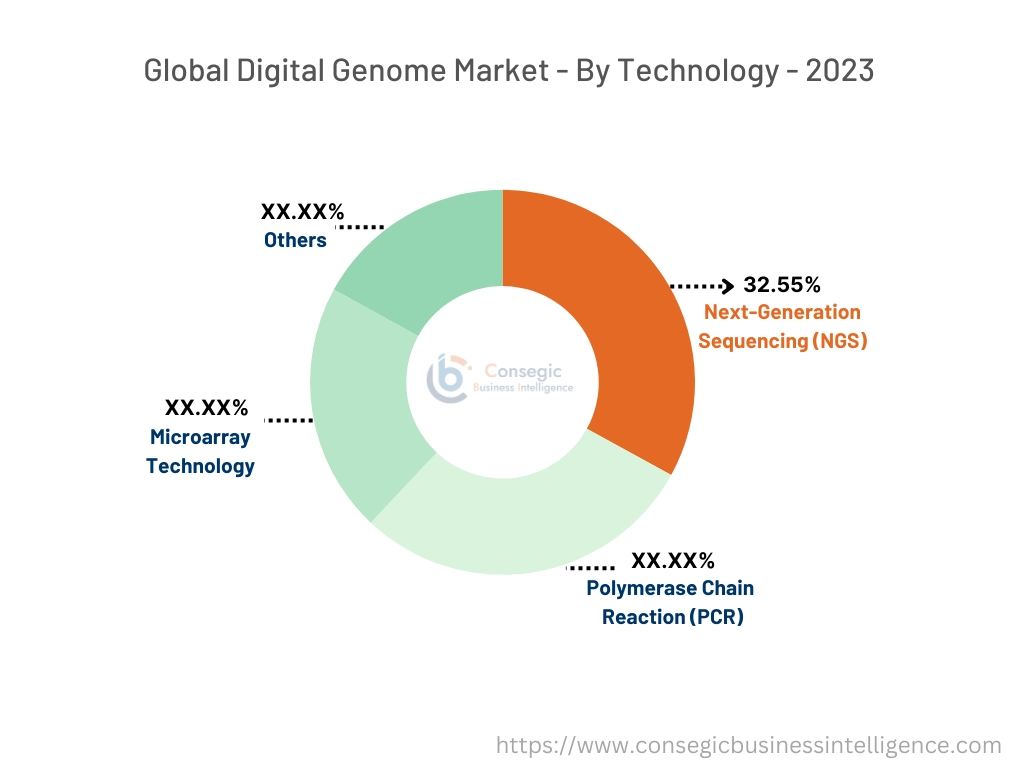
By Application:
Based on application the market is segmented into Microbiology- Biological, Clinical, and Industrial, Diagnostics, Drug Discovery and Development, Personalized Medicine, Agriculture & Animal Research, Forensics, and Others.
Trends in the Application:
- In forensic genomics, the integration of big data and artificial intelligence helps process large datasets and uncover genetic patterns, making it easier to link suspects to crime scenes or exonerate innocent individuals.
- The introduction of portable DNA sequencers for use in the field has transformed how forensic teams collect and analyze DNA evidence.
The diagnostics application accounted for the largest revenue of the overall digital genome market share in the year 2023.
- Common diagnostic tests include screening for genetic conditions like cystic fibrosis, sickle cell anemia, and hereditary cancers which have been integrated into routine clinical practice.
- Genetic profiling of tumors using next-generation sequencing (NGS) allows for the identification of actionable mutations, enabling targeted therapies and personalized treatment plans.
- Pathogen genomics enables precise identification of bacterial and viral infections, antibiotic resistance, and the epidemiological tracking of disease outbreaks, making it indispensable in modern diagnostics.
- Thus, the growing demand for precise, early, and personalized diagnostics across multiple medical fields ensures that this segment will continue to lead the genomic services market shortly, driving the digital genome market expansion.
The personalized medicine segment is anticipated to register the fastest CAGR during the forecast period.
- Personalized medicine is increasingly being used in preventive care, where genomic information helps assess individual risk factors for diseases. This proactive approach enables healthcare providers to offer tailored lifestyle recommendations and early interventions.
- Personalized medicine leverages genomic insights to develop therapies that directly target the molecular drivers of diseases, improving efficacy and reducing side effects.
- Patients are becoming more informed and engaged in their healthcare decisions, seeking personalized treatment options. The availability of direct-to-consumer (DTC) genetic testing has increased awareness and demand for personalized medicine solutions.
- For instance, the Jackson Laboratory states that personalized medicine enables medical professionals to stop the evolution of a disease, lowering the failure rate of pharmaceutical clinical trials, and preventing trial-and-error inefficiency.
- Thus, as per the digital genome market analysis, the personalized medicine segment within the digital genome field is positioned for rapid development due to advancements in technology, increasing adoption of targeted therapies, and a growing focus on preventive healthcare.
By End-User:
Based on end-user the market is segmented into Academic Research Institutes, Diagnostics and Forensic Labs, Hospitals, and Bio-pharmaceutical Companies.
Trends in the End-user:
- The expansion of non-invasive prenatal testing (NIPT), which analyzes fetal DNA in maternal blood, has also contributed to the rising adoption of genomic services in hospitals.
- AI-driven bioinformatics tools are enhancing the ability of bio-pharma companies to analyze massive genomic datasets.
The hospital's application accounted for the largest revenue share in the year 2023.
- Hospitals have been at the forefront of adopting genomic data for precision medicine, where treatments are tailored based on a patient's genetic makeup. This approach is especially prevalent in oncology, cardiology, and neurology, where personalized treatments can greatly improve patient outcomes.
- Hospitals also leverage genomic services for liquid biopsies and tumor marker testing, contributing to early detection, monitoring of treatment response, and cancer recurrence risk assessment.
- Hospitals are leading the adoption of genetic screening for newborns and prenatal testing, which has driven revenue. These tests help detect genetic abnormalities early, allowing for prompt interventions and better management of hereditary conditions.
- Thus, as per the segmental trends, with the ongoing advancements in genomic technology and integration into healthcare practices, hospitals are well-positioned to continue leading the market in offering comprehensive genomic services.
The biopharmaceutical companies segment is anticipated to register the fastest CAGR during the forecast period.
- Bio-pharmaceutical companies are investing heavily in precision medicine to develop treatments tailored to individual genetic profiles. As the understanding of how genetics influence drug response grows, pharmaceutical companies are using genomic data to design drugs that target specific genetic mutations or pathways.
- The development of biologics, including monoclonal antibodies and cell and gene therapies, is one of the fastest-growing areas in the pharmaceutical industry.
- Thus, their ability to leverage genomic data for targeted therapies, particularly in oncology and rare diseases, coupled with technological innovations in AI and bioinformatics, boosts the digital genome market expansion.
Regional Analysis:
The regional segment includes North America, Europe, Asia Pacific, the Middle East and Africa, and Latin America.
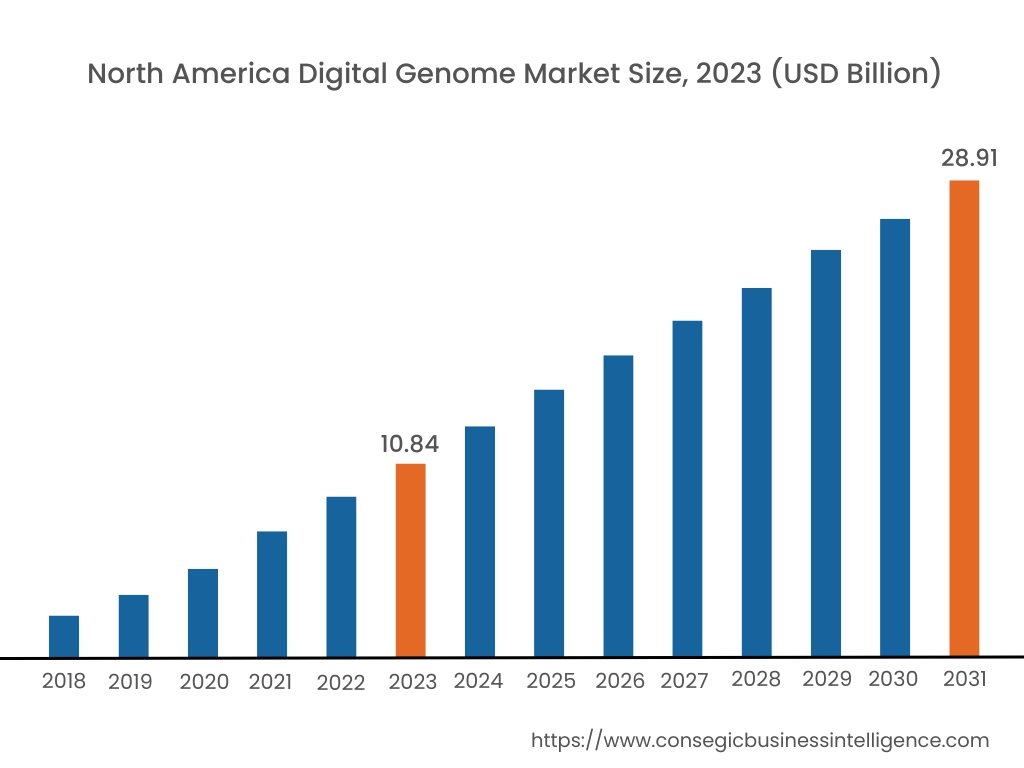
In 2023, North America accounted for the highest market share at 41.65% and was valued at USD 10.84 Billion, and is expected to reach USD 28.91 Billion in 2031. In North America, the U.S. accounted for the highest market share of 76.44%during the base year of 2023. As per the digital genome market analysis, North America has a well-developed healthcare infrastructure that integrates genomic data with electronic health records, enabling clinicians to use it for personalized plans. The US is at the forefront of genomic technologies with advanced capabilities in AI-driven genomic analysis, and bioinformatics.
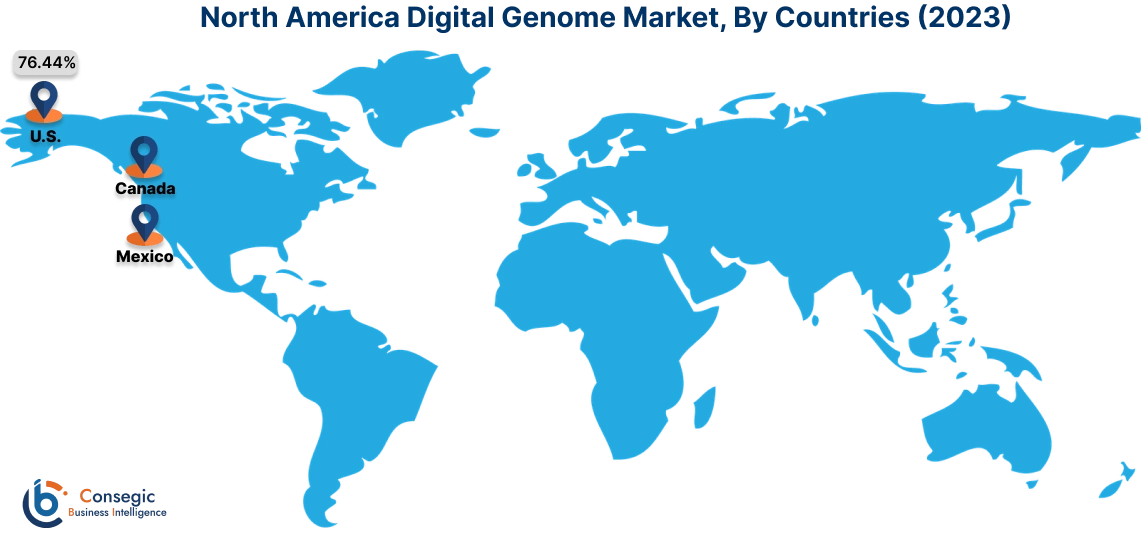
Asia Pacific is expected to witness the fastest CAGR over the forecast period of 13.9% during 2024-2031. The Asia Pacific region is emerging as a significant player in the global digital genome market, driven by advancements in healthcare infrastructure, an increase in genomics research, and rising demand for personalized medicine. Countries like Japan, and South Korea have made significant strides in precision medicine, integrating digital genomic data with healthcare systems.
- In 2024, the Macrogen's main laboratory is located in Korea and is certified by the Korean Ministry of Food and Drug Safety's NGS Clinical Laboratory and the Korean Institute of Genetic Testing Evaluation.
In Europe, genetic testing has become more widespread driven by the growing awareness of the potential benefits of genomic data in diagnosing and treating diseases. Countries like Switzerland, Netherlands, and Belgium have strong biotech sectors which are focused on advancing genomic technologies further. The Middle East and Africa region digital genome market is in its early stages but it's witnessing gradual growth as efforts are being made to develop genomics research capabilities and integrate precision medicine. Countries like Saudi Arabia and Qatar are leading genomic research sponsored by government programs. Latin American countries are partnering with international organizations and academic institutions to access cutting-edge genomic technologies. The region is seeing a rise in genomics startups, especially in Brazil and Chile.
Top Key Players & Market Share Insights:
The digital genome market is highly competitive with major players providing precise measurement between objects to the national and international markets. Key players are adopting several strategies in research and development (R&D), product innovation, and end-user launches to hold a strong position in the global digital genome market. Key players in the digital genome industry include-
- Illumina, Inc. (USA)
- Thermo Fisher Scientific, Inc. (USA)
- QIAGEN N.V. (Germany)
- Agilent Technologies, Inc. (USA)
- Pacific Biosciences of California, Inc. (USA)
- F. Hoffmann-La Roche AG (Switzerland)
- Bio-Rad Laboratories, Inc. (USA)
- Oxford Nanopore Technologies Ltd. (UK)
- PerkinElmer, Inc. (USA)
- BGI Genomics Co., Ltd. (China)
Recent Industry Developments :
Partnerships and Collaborations:
- In April 2024, Health Data Research UK (HDR UK) and the Global Alliance for Genomics and Health (GA4GH) announced a strategic partnership for combining genetic with medical data. It will support HDR UK in expanding its existing open standards work and facilitating collaboration with other organizations and initiatives in the health space.
Product Launches:
- In September 2024, genomic unity 2.0, a whole new genome diagnostic test which has been introduced by Variantyx. It combines Oxford nanopore-based long-read sequencing with short-read sequencing.
Product Enhancement:
- In September 2024, Ambry Genetics expanded the range of tests it offers to identify genetic mutations. Updates have been made to the BRCANext, ColoNext, and CancerNext test panels for hereditary cancer.
Digital Genome Market Report Insights :
| Report Attributes | Report Details |
| Study Timeline | 2018-2031 |
| Market Size in 2031 | USD 68.92 Billion |
| CAGR (2024-2031) | 13.2% |
| By Product |
|
| By Technology |
|
| By Application |
|
| By End-User |
|
| By Region |
|
| Key Players |
|
| North America | U.S. Canada Mexico |
| Europe | U.K. Germany France Spain Italy Russia Benelux Rest of Europe |
| APAC | China South Korea Japan India Australia ASEAN Rest of Asia-Pacific |
| Middle East and Africa | GCC Turkey South Africa Rest of MEA |
| LATAM | Brazil Argentina Chile Rest of LATAM |
| Report Coverage |
|
Key Questions Answered in the Report
How big is the Digital Genome Market? +
The Digital Genome Market size is estimated to reach over USD 68.92 Billion by 2031 from a value of USD 26.03 Billion in 2023, growing at a CAGR of 13.2% from 2024 to 2031.
Which is the fastest-growing region in the digital genome market? +
The fastest-growing region in the digital genome market is Asia Pacific.
What specific segmentation details are covered in the digital genome market report? +
The specific segments that are covered in the digital genome market are product, technology, application, and end-user.
Who are the major players in the digital genome market? +
The major players in the digital genome market are Illumina, Inc. (USA), Thermo Fisher Scientific, Inc. (USA), F. Hoffmann-La Roche AG (Switzerland), Bio-Rad Laboratories, Inc. (USA), QIAGEN N.V. (Germany), Agilent Technologies, Inc. (USA), Pacific Biosciences of California, Inc. (USA), Oxford Nanopore Technologies Ltd. (UK), PerkinElmer, Inc. (USA), and BGI Genomics Co., Ltd. (China).
